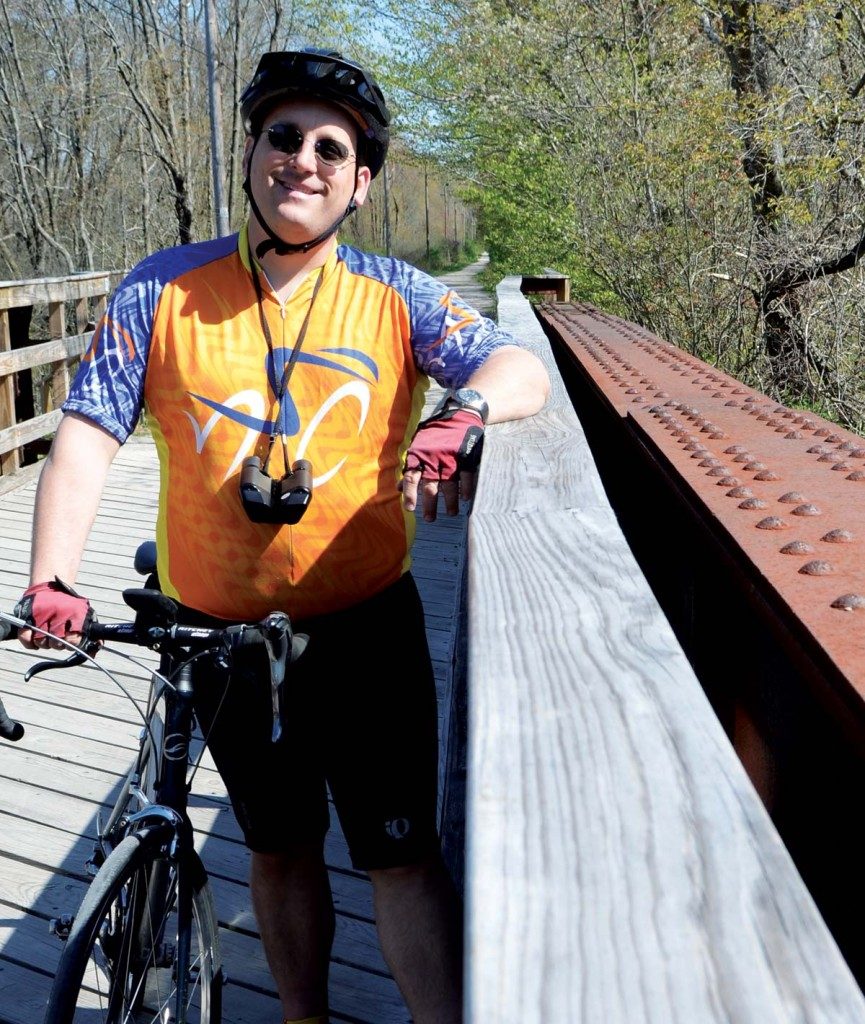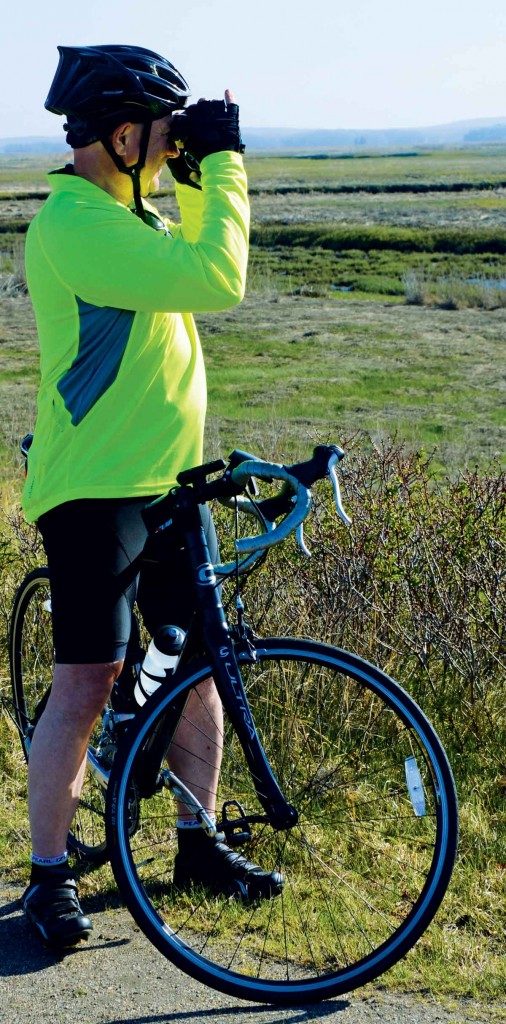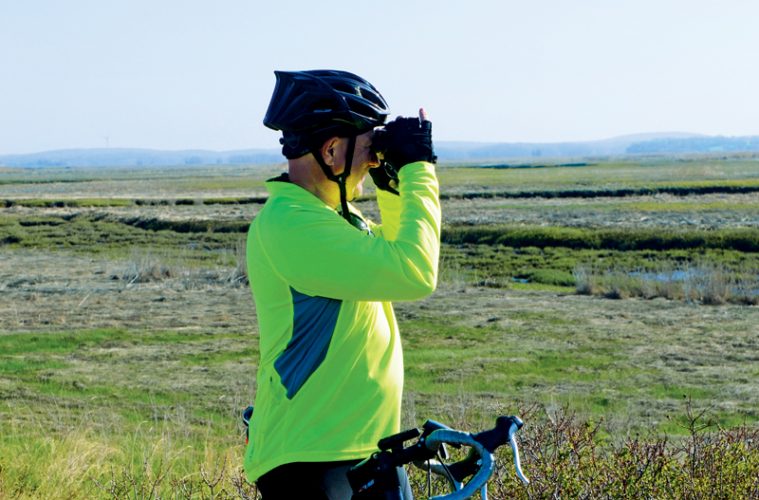A system of area bicycle trails is attracting a crop of outdoor enthusiasts who prefer to combine biking with birding.
On any given Saturday morning, Diane Mutchler hops on her bicycle and heads north from her home in Melrose, then east to one of her favorite places on the North Shore: Parker River National Wildlife Refuge on Plum Island. An 86-mile ride (round trip), she leaves early and stops often for pictures with her camera, especially when she arrives at the flat Refuge roadway, where the speed limit is low. “Cars don’t go zooming by, the traffic is light, and the salt air smells great,” Mutchler says.
But something else on the road always catches her attention: birds. Or, rather, birders.
“I often notice people along the side of the quiet roadway with their telescopes and fancy cameras, observing the many types of birds and wildlife on the Refuge,” Mutchler explains. “It’s a beautiful place to be on a bicycle. As I tell people, ‘It’s the ultimate convertible!’”
It turns out that riding your “ultimate convertible” on Boston’s North Shore is also one of the best ways to catch sight of the area’s more than 400 species of birds. In fact, many cyclists who spend their summer days pedaling the marshy roads of Essex and Ipswich or along Marblehead’s oceanfronts also pack binoculars, just in case a winged friend decides to come along for the ride.
For the area’s birders-on-wheels, the North Shore has some of the most spectacular spots around, and Plum Island’s Wildlife Refuge tops the list. With 4,600 acres on this barrier island and elements such as a salt marsh habitat, dunes, beach, maritime forest, fresh water, and brackish water impoundments, the Refuge is a favorite destination for both bicyclists and birders.
“The Refuge is one of the finest birding areas in the nation, with more than 350 species recorded,” says Sue McGrath, founder and program designer of Newburyport Birders, a local organization that offers a range of birding classes, events, and tours—walking, not cycling. The diversity of birds migrating here reaches its peak, McGrath says, in the last half of May, when “a day’s tally may result in 100 or more species. Major waves of passerines, especially warblers, vireos, thrushes, and flycatchers, are the main attraction.” But McGrath says good birding continues into early June with the migrating passerines—those small, perching songbirds that includes more than half of all species. (Think finches, sparrows, or jays.) By early July, southbound shorebird migrants begin to arrive, with numbers peaking in August.
That’s good news for cyclists and bird enthusiasts like Jeff Cox. Cox, who is “fascinated by all kinds of birds, how they move, and who they’re with,” is also the president of North Shore Cyclists, a club that plans year-round rides and events for all levels and ages. With 330 members ranging in ages from 20 to 85 years old, North Shore Cyclists provides “a friendly atmosphere for people who like to ride bikes.” From creating maps and road markers for recreational rides with other cyclists to organizing charity rides, the group helps to make cycling accessible—and social—for anyone.
“Cycling is something everyone can do, [and it has] benefits, like fitness and awareness of the world and of the environment,” Cox says. “You see things you’d miss driving in a car. Birding and biking are both about being aware of your surroundings; getting connected again when it’s so easy in this world to feel disconnected.”

Jeff Cox on the Topsfield Rail Trail
Admittedly, not all members connect to what NSC member Sarah Weaver calls “the great marriage of activities.” Weaver herself takes advantage mostly of the “loads of wonderful roads for cycling around the Andovers, Boxford, Topsfield, Middleton, Groveland, and Newbury.” And for non-birding bikers, she hosts an August 4 ride called “Pigs, Ponds, and Potholes,” a route that rides past each and ends with a party at her home in North Reading.
Though the great spots for birding can be found among the Andover Village Improvement Society, Trustees of Reservations, converted rail trails, and state forests, Weaver says it can be a tricky combination for a club ride with others. “Presumably you’ve joined because you want to ride with people, and that means you have to pay attention to those around you—you can’t always be looking skyward,” she says. “You can, of course, stop at any promising birdwatching locale, but unless you’re riding with friends who want to do the same, you’ll lose your fellow riders.”
Still, the “marriage” of birding and biking is one worth tackling, and the secret to a blissful union, Cox says, is that there is no secret. Some cyclists choose long rides to Plum Island or Marblehead Neck Wildlife Sanctuary for watching birds—and birdwatchers—along the way. Then there are the slower rides, like the kind Cox’s wife, Barbara, enjoys. The pace is slow enough “to see the berries on the bushes,” he says, and the point is to experience more of the surroundings, to identify various species of birds, or simply to watch the sea gulls.
“My wife’s the perfect birding biker—she loves to go slow and look around,” says Cox, who often rides with her through Lynn to Nahant Island because of the combination of sea, wind, and birds. “I’m the kind of guy who’s got to be on the move all the time, but she’s not interested in the longer, faster rides. So my job [when we bike together] is to take pictures that she then scrapbooks. She’s the family historian, and we have scrapbooks of biking trips and the birds we see.”
Because biking tends to invite more engagement with the world, Cox says cyclists in general—and members of North Shore Cyclists in particular—tend to be “the kind of people who are very involved in the community, historic societies, Boy Scouts, you name it,” he says. “In our club, you meet the most interesting and fascinating people, and because we’re a generalist recreational club, it’s a great place to get started.”
Naturally, then, many cyclists are also loyal members of the Mass Audubon Society, which provides online checklists of species for each of the wildlife refuges in the region.
Ted Olsson, for instance, an Audubon member who lives in West Newbury, has been birding for more than 30 years. Three years ago, he took up road cycling for fitness reasons and joined the North Shore Cyclists. He was surprised to discover how much the two outdoor activities went together, especially as he ventured into the Refuge at Plum Island, as well as the marshes, woods, and wildlife along Route 1A, plus Byfield’s wildlife refuge. He’s since dodged wild turkeys, admired ducks on the river, felt the stare of a snipe, and watched hawks glide over him.
“Late summer, when the swallows are out and you’re on a ride, sometimes you feel like you’re flying with them,” says Olsson. “As you’re pedaling, you see all sorts of birds, and sometimes you can sort of feel like you’re one with them. I wouldn’t have thought that a great benefit to cycling was also seeing so many birds, but as I ride and I’m able to identify them, it’s that much more enjoyable.”

Ted Olsson, North Shore Cyclists
Olsson says that birding while biking requires him to use all his senses, giving him a richer experience. Many times, he says, birds don’t react to cyclists in the same way they do cars or even hikers, perhaps because riding is often quiet, smooth, and rhythmic, so the birds don’t startle as easily as a cyclist approaches. That means a birding biker has a better chance to observe and hear a variety of species.
“There is a sort of spiritual aspect to connecting with wildlife [that have] lived there long before you,” Olsson says. “On some rides, I listen for bird calls and identify birds this way. For example, Carolina wrens are more common in the area, probably due to global warming. My rides are typically 30 to 40 miles, and sometimes, it seems like these wrens are following my route. I’ll hear four or five on the ride, but, of course, they are different birds in their different territories…I think!”
Most birders keep a record of the birds they’ve seen, says Olsson, who keeps his checklist on his phone. Some take it more seriously than others, but all agree that the “in-between pace” is best, where they can cover distance but move slowly enough to pay attention to their surroundings. Most cyclists pedal about 15 to 20 miles an hour, which is still slower than the modern car speed and allows them to see more. Of course, most would also agree that if you’re considering a birding ride, it’s probably best to stop your bike first before you pull out your binoculars. For those who do, the experience is hard to beat.
“We humans think we’re pretty great until we watch a bird and we realize we can’t fly,” Cox says. “They’re amazing, mystical, with their markings, songs, colors, varieties. It’s all…magical and encourages us to be at harmony with ourselves and with nature. Birding and cycling helps us to wake up and to take the opportunity to look up.”
Bird Is the Word – Some of the best spots for bird sightings.
For Joe Geller, chairman of the Topsfield Rail Trail Committee, the best location he knows of to see birds is on the Beverly-Salem Waterway Canal, just off the Topsfield Linear Common south of the Ipswich River Bridge. Cyclists can ride there, park, and walk the two-mile long canal off the Ipswich River, which feeds Wenham Lake.
Jim McGrath, who runs Easy Rider Tours, says other excellent biking roads for spotting birds include Scotland Road because of its good shoulder. (He recently saw a red-shouldered hawk perched there.) Other great options for cycling and birding include Turkey Hill Road along the Artichoke Reservoir, Newman Road along the marsh, and Old Town Hill, as well as Middle Road in Newbury, between the Parker River and the Governor’s Academy. McGrath says to watch for egrets and Great Blue Herons, both frequent visitors to the marshy areas.
Linked In – Reliable online resources for biking and birding in our area.
Biking
Birding

